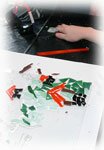Glass Geometry
Mathematically correct Lighting and Sculpture
When you get acquainted with the works on our site, you should remember not only the utilitarian component, but also the aesthetic, contextual one. If you want to read a more scholarly source on this topic, ib essay writing service can help you with that.











The following lines are a short explanation of the shapes I work with and a bit of theory around them.
There is no harm in skipping all this, just as it may be kindling your interest if you continue.
So here goes: solid geometry deals with space enclosed by surfaces, or faces. So we can say that the space of a cube is enclosed by six squares (hence the proper name hexahedron. Hexa is Greek for six, hedron means face). A square is a regular polygon (poly = many, gon = side) with four sides, that is all sides are the same, and all angles are the same. A regular polyhedron would therefore be made up of regular polygons. Only four more regular polyhedra are possible: the tetrahedron, made up of four (tetra = four) equilateral triangles, the octahedron (octa = eight) made up of eight equilateral triangles, the icosahedron (icosa = twenty) with twenty equilateral triangles and lastly the dodecahedron, comprised of twelve pentagons (do = two, deca = ten, 2+10=12).But that is not all. These five regular solids, aka Platonic Solids, have relationships to each other. If all midpoints of the faces of a solid are connected to the face next to it we get another regular solid. In the case of the tetrahedron there will be another tetrahedron, albeit upside down from the original. When the midpoints of the faces of a hexahedron (cube) are connected to the faces next to it we find an octahedron, and, upon connecting the midpoints of the faces of an dodecahedron to the faces next to it we have an icosahedron. And this works both ways: an icosahedron has a dodecahedron in it, the cube is dual to the octahedron and the tetrahedron is, you guessed it, self-dual.